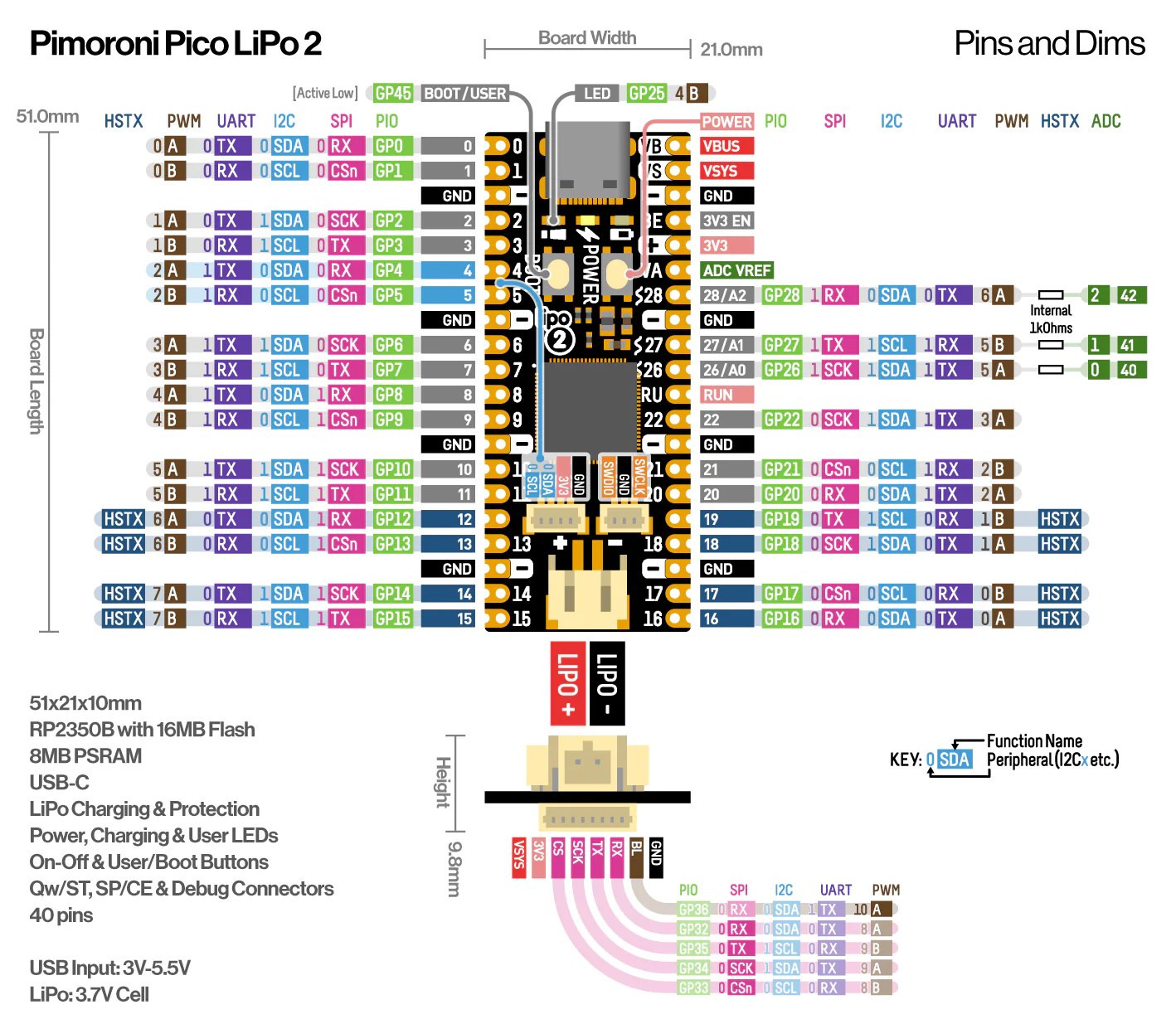Psst - looking to use the mighty RP2350 microcontroller as the brains in your project, but want more features than are present on a vanilla Raspberry Pi Pico 2? Pimoroni Pico boards are souped up dev boards, with all the tasty extras baked in ????
Pimoroni Pico LiPo 2 is powered and programmable via USB-C and comes with an upgraded 8MB RAM, 16MB of flash storage and easy to read pin labels. It's got onboard LiPo/LiIon battery management - the inbuilt charging circuitry means charging your battery is as easy as plugging your board in via USB. There's two indicator LEDs connected to the battery circuit to keep you informed of on/off state and charging status and it's compatible with LiPo, LiIon and high capacity LiPo batteries. There's also a handy power button and a BOOT button, which can also be used as a user switch.
It's super easy to connect up to things without soldering, with a Qw/ST connector (for adding I2C sensors and breakouts), a SP/CE connector (for hooking up SPI/serial breakouts or for adding a RM2 wireless breakout) and a debug connector (for if you prefer to program using a SWD debugger).
Features
- Powered by RP2350B (Dual Arm Cortex M33 running at up to 150MHz with 520KB of SRAM)
- 16MB of QSPI flash supporting XiP
- 8MB of PSRAM
- MCP73831 charger with 215mA charging current (datasheet)
- XB6096I2S battery protector (datasheet)
- USB-C connector for power, programming, and data transfer
- Qw/ST (Qwiic/STEMMA QT) connector for attaching I2C breakouts
- SP/CE connector for attaching SPI/serial devices
- 3 pin debug connector (JST-SH)
- Switch for basic input (doubles up as DFU select on boot)
- Power button
- Power, charging and user LED indicators
- On-board 3V3 regulator (max regulator current output 600mA)
- Input voltage range 3V - 5.5V
- 2-pole JST PH battery connector, with polarity marked on the board
- Two rows of 20 pins, exposing 26 GPIO
- Compatible with Raspberry Pi Pico add-ons
Batteries, cables and headers are not included.
What's in the box?
1 x Pimoroni Pico LiPo 2
Resources
Pinout and Schematic

Getting Started
If you're new to working with RP2350 boards we'd recommend starting with our custom MicroPython build, which includes support for our breakouts and Pico add-ons.
Connecting Breakouts
Pico Lipo 2 XL W has both a Qw/ST (AKA Qwiic/STEMMA QT) connector and a SP/CE connector. You can easily connect up Qw/ST breakouts using a 4-pin JST-SH to 4-pin JST-SH cable and SP/CE breakouts using a 8-pin JST-SH to 8-pin JST-SH cable.
- ⚠️ You should only use Pimoroni Pico LiPo 2 with LiPo or LiIon batteries, and you should make sure that any project involving LiPos is sufficiently protected from being dented, bent, punctured or crushed.
- Measurements: approx 53mm x 21mm x 10mm (L x W x H, including connectors)
- The user LED is wired to GP25, just like on an ordinary Pico. You can blink it in exactly the same way!
- As well as being useful for putting your Pico LiPo 2 into bootloader mode, you can also use the BOOT button as a user button. It's wired to GP45 and active low.
- VBus Sense is wired to GP24 and VBat Sense is wired to GP43.
- For uses requiring very low power draw, the power LED can be disconnected by cutting the trace on the rear of the board labelled with a LED symbol, near the USB-C end.
- For high power draw uses over 800mA, the battery protector can be bypassed by soldering the trace labelled "+1A Mode". Make sure your battery can safely deliver this amount of current before doing this.
About RP2350
The RP2350 chip is the Double Quarter Pounder & Fries to the RP2040's Double Cheeseburger and can have one or more RISC-V burgers instead of either of the M33 ARMs, to stretch the metaphor.
In addition to the modern M33 ARM cores, there are sides of: more PIO capability, a variety of low power states for sipping electrons, a whole security system and some sprinklings of specialist digital video circuits to offload DVI/HDMI output.
You can expect a tasty boost in performance - our "real world" MicroPython tests are running up to 2x faster compared to RP2040, and floating point number crunching in C/C++ is up to 20x faster. The extra on-chip RAM will make a big difference when performing memory intensive operations (such as working with higher resolution displays) and even more can be added thanks to external PSRAM support.
RP2350 comes in two flavours - A (standard) and B (all the pins). The B chip has a stonking 48 usable GPIO pins, including 8 ADCs and 24 PWMs, and features on some of our new products.















